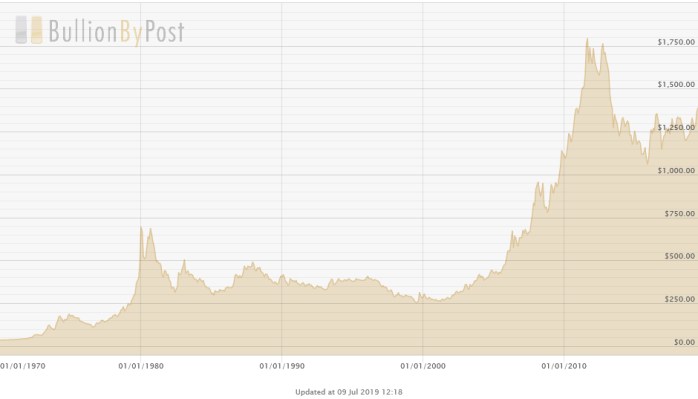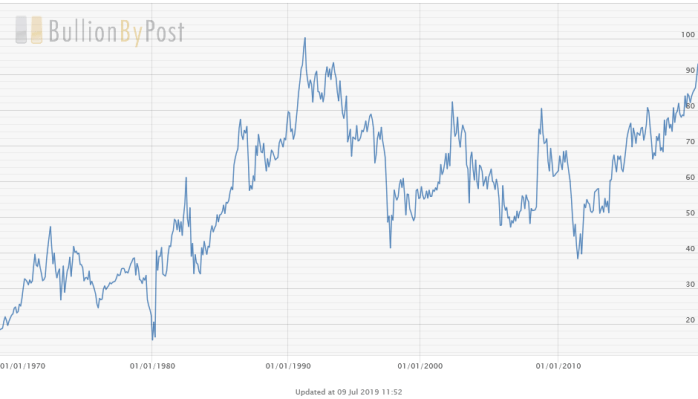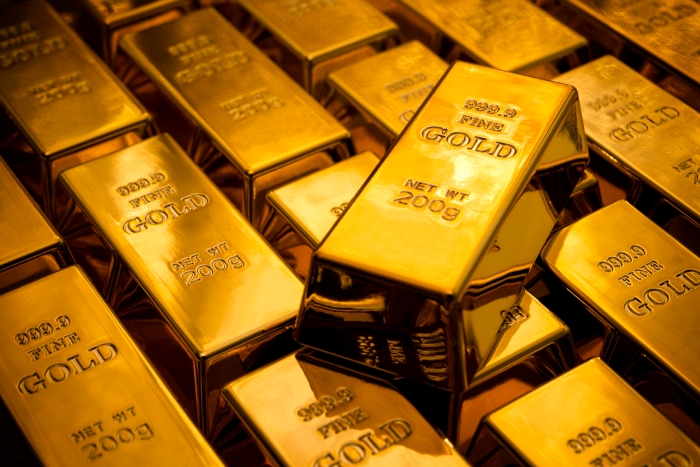
Silver is currently an interesting commodity and precious metal to be watching. During the last spike in the price of gold over the previous two weeks, the silver price barely moved. In fact, the silver price has been depressed for some time now.
Below I am featuring three charts. The first chart shows the silver price per ounce in dollars over the last 50 years, the second chart shows the gold price per ounce in dollars also over the last 50 years, whilst the last chart shows the silver to gold ratio over that same time frame. The last chart is more interesting to me, as the current silver to gold ratio stands at 92. In other words, one unit of gold is currently equal to 92 units of silver. During the last 50 years this ratio has traded at a range between 100 and less than 20.
The silver price per ounce over the last 50 years (as of 9th July 2019)

The gold price per ounce over the last 50 years (as of 9th July 2019)

Silver to gold ratio chart over the last 50 years (as of 9th July 2019)

Silver has been derided many times as a ‘poor man’s gold’. It is a misunderstood commodity and is currently not very fashionable. In fact, precious metals generally are not really in vogue, especially amongst a lot of younger people who have more of an interest in cryptocurrencies. I am also interested in cryptocurrencies, but they are very hot right now, whereas precious metals are generally not. The recent price rise in gold was very modest when one compares the price rise of Bitcoin over the last few months, which propel some to deem Bitcoin and other cryptocurrencies as the new store of value assets and gold and silver as store of value assets of the past. Bitcoin has many times been hailed as the new gold or ‘digital gold’; a supply-capped gold powered by electricity. On the other hand, one could also argue that gold is Bitcoin without electricity or the internet.
But all the noise aside, lets get back to the fundamentals. There is an insightful article on the Royal Mint website regarding the scarcity of precious metals on this planet. The article entitled, How Rare Are Precious Metals?, discusses the ‘mass fraction’ of precious metals or how many kilograms of precious metals exist in the Earth’s crust per billion kilograms of crust material. According to the statistics in the article, gold represents 4kg per billion kg of crust material and silver 75kg per billion kg of crust material. This means that gold is around 18-19 times scarcer than silver. Yet today it is priced 92 times higher. One reason for the depressed price of silver could be that in many countries the purchasing of silver coins or bullion from a registered dealer such as Sharps Pixley incurs additional VAT costs. This also explains why the price of silver coins and bars in those countries are higher than the spot price of the metal. However in some cases silver is exempt from VAT charges if it is kept in a vault provide by the dealer. Gold, on the other hand, is exempt from VAT either way, which explains why the price of gold coins and bars is closer to the spot price.
Both gold and silver are insurance assets in an unstable, unpredictable and financially indebted world. Yet right now it is silver that arguably has greater potential upside. Even though gold is used to a small degree in industry, silver is used on a far greater scale, meaning it is not purely just a store of value. As with crude oil, a severe disruption to its supply would cause the price to spike in a very short space of time.
As silver can be quite impractical and costly to store in great quantities, an alternative way of investing in pure silver is via an Exchange Traded Fund or ETF. It is important though to select an ETF where each unit is directly backed to a physically held unit of silver. The added beauty too of a silver ETF is that you are investing in silver at pretty much the spot price. The ETFS Metal Securities Ltd Physical Silver (PHSP) is a good one with a modest annual charge of 0.49%. Vanguard specialise in ETFs and their silver ETF may have even lower charges. I also highly recommend purchasing silver via Bullion Vault. You can invest in silver very close to the spot price and have it stored in a vault in selected cities around the world. Their monthly storage charges are also very reasonable. Yet one of the advantages of a pure ETF is that it can be put in an ISA meaning you want have to pay capital gains tax.
Investing in silver mining companies is another way of gaining exposure to the price of silver. Sometimes the gains can be higher than owning physical silver or an ETF. Yet you take on additional risk such as political risk and also company mismanagement. One of the largest publicly traded silver mining companies is the Mexican based company Fresnillo (FRES). There are also a bunch of smaller publicly traded silver mining and exploration companies, but these carry more risk.
There are many places to purchase physical silver coins and bars. I like Sharps Pixley and Bullion By Post. The latter is a little more expensive but has a greater range of silver products. The Royal Mint is the UK’s official precious metals mint but prices are also not cheap. A smaller silver trader I like very much is the Newcastle based Silver Trader run by Martin Whitehouse. He sells silver coins and bars, which other leading dealers don’t stock. Furthermore, he also sells silver coins and bars via Ebay and has lots of positive feedback.
By Nicholas Peart
(c)All Rights Reserved
Sources:
Main image: atlantagoldandcoin.com
Graphs extrapolated from the website Bullion By Post
